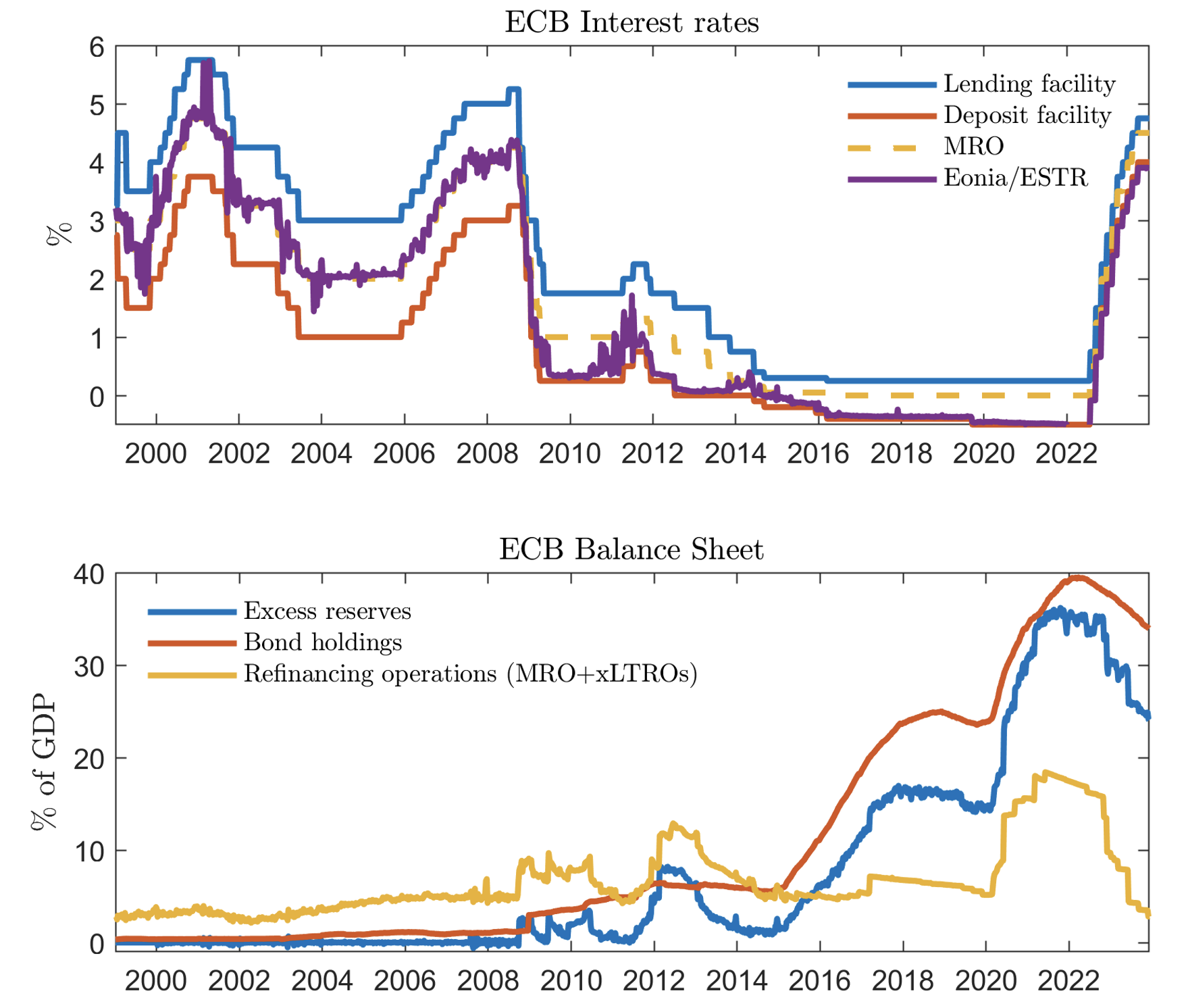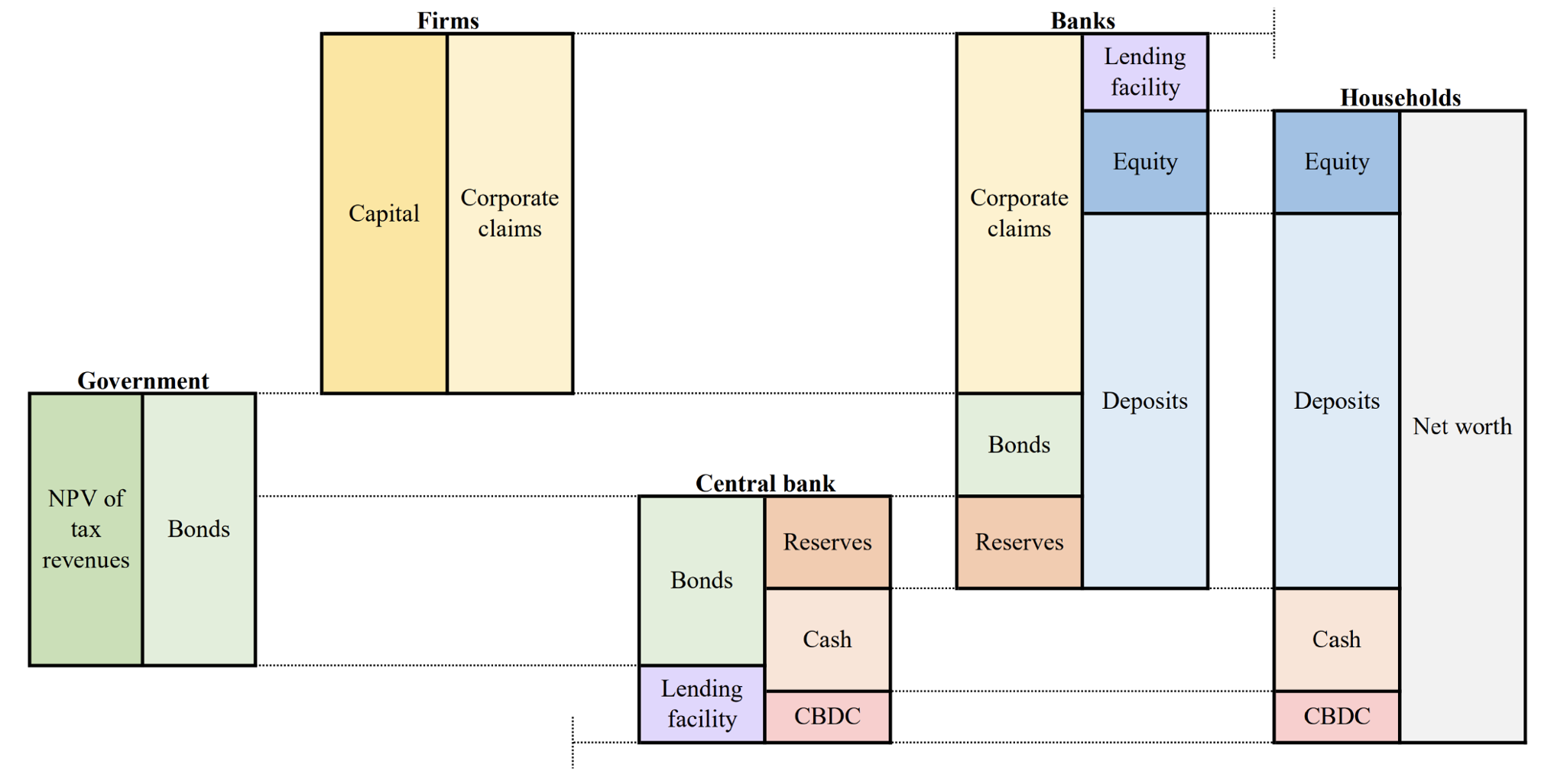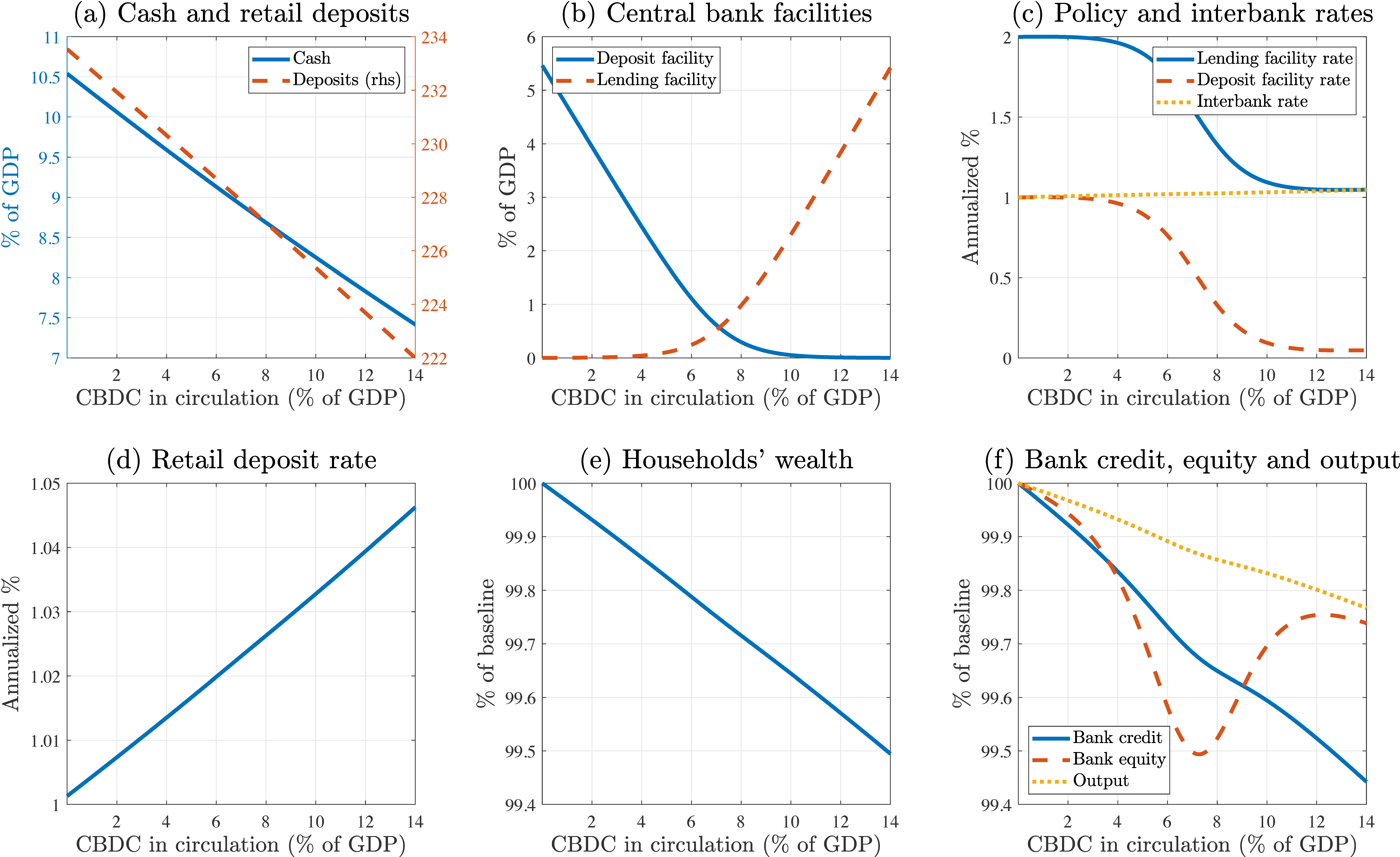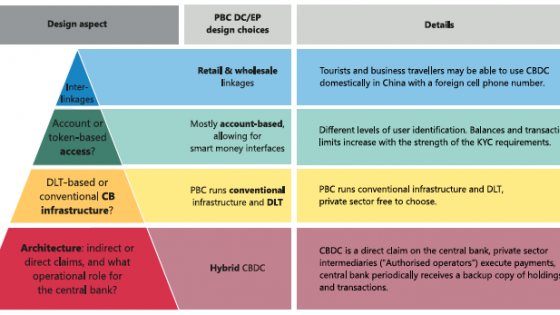Recent times have witnessed a shift in central bank attitudes towards the possibility of issuing their own digital currencies. The introduction of central bank digital currencies (CBDCs) is now being explored by central banks in major advanced economies. In March 2022, US President Biden’s Executive Order on Ensuring Responsible Development of Digital Assets placed “the highest urgency on research and development efforts into the potential design and deployment options of a United States CBDC.” Similarly, in October 2023 the European Central Bank (ECB) announced the start of the preparation phase of its ‘digital euro’ project, aimed at laying foundations for a potential euro area CBDC.
While the motivation for their introduction is still a matter of debate (e.g. Schoenholtz and Cecchetti 2021), much has been discussed about the potential implications of central bank digital currencies from a wide range of different perspectives. Recent research has placed a particular emphasis on monetary policy transmission (Burlon et al. 2022, Kumhof et al. 2023) and price stability (Schilling et al. 2021), bank intermediation (Chiu and Rivadeneyra 2021) and financial stability (Muñoz and Soons 2023), as well as on the design options such as those affecting privacy (Ari et al. 2020, Keister and Monnet 2021) and remuneration (Bindseil and Panetta 2020), and their implications for the efficiency of the financial system architecture (Niepelt 2023). Much less attention, however, has been devoted to their impact on the monetary policy implementation framework and how this is likely to shape the macroeconomic effects of central bank digital currencies.
Monetary policy in a floor system
Nowadays, many central banks in advanced economies de facto operate a ‘floor system’, following the significant expansion of their balance sheets in the aftermath of the global crisis. In this system, banks’ demand for liquidity is satiated with an ample supply of central bank reserves, and interbank market rates are effectively controlled by the interest rate on overnight deposits at the central bank (see Figure 1).
The introduction of a central bank digital currency has the potential to affect the operational framework of monetary policy and the conditions in interbank markets if it brings about a sufficiently large decrease in excess reserves due to the reduction in bank deposits. This, in turn, may have important macroeconomic implications, both in the long run and in the transitional central bank digital currency adoption phase.
Figure 1 ECB interest rates and balance sheet composition, 1999-2023
Note: The top panel shows the monthly evolution of the ECB’s policy rates on its standing facilities and its main refinancing operations (MRO), as well as its operational target (Eonia, from 1999 until 2021, and €STR, from then on). The bottom panel shows the level of excess reserves, bond holdings, and refinancing operations on the ECB’s balance sheet, divided by euro area GDP (linearly interpolated to monthly frequency).
Central bank digital currency introduction and monetary policy implementation
In this column we examine the implications of the introduction of central bank digital currency for the operational framework of monetary policy and for the macroeconomy as a whole, drawing from our recent research (Abad et al. 2024). In this work, we introduce central bank digital currency in a tractable New Keynesian model with heterogeneous banks, a frictional interbank market, a central bank that operates standing (deposit and lending) facilities, and household preferences for different liquid assets. Figure 2 presents an overview of the different agents in our model economy, the composition of their balance sheets, and how they are interrelated. We calibrate our model to the euro area, replicating key features of the balance sheet of the Eurosystem and the consolidated commercial banking sector, as well as the relationship between aggregate excess reserves and money market rates. The core of our analysis is on the long-run effects of introducing non-remunerated central bank digital currency. In particular, we conduct a comparative statics exercise, summarised in Figure 3, in which we vary households’ long-run preferences for central bank digital currency, effectively comparing steady states with a different equilibrium demand for this currency. This way we do not try to forecast how successful central bank digital currency might be, but instead we consider a range of scenarios and explore their implications.
Our analysis predicts that households’ demand for non-CBDC liquidity (bank deposits plus cash) falls essentially one-for-one with CBDC demand, but the bulk of the adjustment (about three quarters) falls on bank deposits (Figure 3, panel a). Therefore, relatively large levels of CBDC adoption come hand in hand with a ‘deposit crunch’ on the banking sector. However, the latter does not imply a ‘credit crunch’: even large reductions in deposit funding have rather small effects on bank lending to firms, and therefore on productive investment and GDP (panel f). For instance, a level of CBDC adoption equivalent to 14% of GDP reduces bank deposits by 11% of GDP, but this lowers bank lending by less than 0.6% and GDP by barely 0.25%. The endogenous response of the central bank’s balance sheet and its interest rate policy is crucial to understand these results.
Figure 2 Balance sheets of the different consolidated sectors of the model economy
Getting up from the floor
At the core of the mild effects on bank lending lies the impact that CBDC has on the central bank’s monetary policy operational framework. Our initial (no CBDC) steady state is consistent with the ‘floor system’ currently implemented by the ECB and other central banks in advanced economies, characterised by an ample supply of central bank reserves and interbank rates pushed against the remuneration of reserve deposits. For long-run levels of CBDC adoption below 4% of GDP, equivalent to CBDC holdings of about €1,900 per adult person in the euro area, the reduction in bank deposits is essentially absorbed by an almost one-for-one fall in reserve balances at the central bank (panel b). This allows the banking sector to preserve most of its lending to the real economy despite the fall in deposits. Within this range of CBDC demand, the floor system is preserved. As CBDC adoption goes beyond that level, some banks start borrowing from the central bank lending facility and the floor system is replaced by a ‘corridor system’, characterised by a low level of central bank reserves and interbank market rates standing around the midpoint of the interest rate corridor. For CBDC adoption levels exceeding 10% of GDP (equivalent to holdings of about €4,800 per adult person), there are no reserves left to absorb the contraction in bank deposits. Instead, banks replace the lost deposits–and thus continue to preserve most of their lending to firms–by increasing their recourse to the central bank’s credit facility. At those levels of CBDC demand, the corridor system gives way to a ‘ceiling’ system, characterised by scarce (in fact, zero) reserves and interbank rates pushed against the lending facility rate. The endogenous response of the central bank, by lowering its policy rate corridor when excess reserves start to become scarce and recourse to its lending facility increases, guarantees that banks are able to substitute their deposit funding with central bank credit without affecting their overall funding costs (panel c).
Figure 3 Long-run variables as a function of demand for central bank digital currency
Note: This figure displays the long-run (steady state) values of selected endogenous variables of the model for different levels of equilibrium demand for CBDC. Variables presented as ‘% of GDP’ refer to percentages of annualised output; those presented those presented as ‘Annualized %’ refer to annualised percentage points; and those presented as “% of baseline” refer to percentages of the corresponding value in the baseline model without CBDC.
Macroeconomic implications
While small compared to its impact on the banking sector, the effect of CBDC on real outcomes is nonetheless far from negligible. In other words, CBDC is not neutral in the sense of Brunnermeier and Niepelt (2019) as it affects prices and macroeconomic aggregates. In our model, the non-neutrality of CBDC is a consequence of two different channels.
First, there is a remuneration of households’ savings channel, by which demand for (non-remunerated) CBDC implies a lower average return on households’ optimal liquidity basket and hence a reduction in households’ savings (panel e). This leads to a decline in investment and physical capital, which reduces output and consumption. These effects are larger the larger the CBDC take-up is.
Second, there is an operational framework channel, which becomes active when CBDC adoption is such that the operational framework transits to a corridor system. Under a corridor system, banks that borrow from the central bank’s lending facility do so at a higher cost than in the interbank market, and banks that lend their liquidity to the deposit facility receive a lower remuneration than in the interbank market. Both factors hurt overall bank profitability and hence bank equity, which in turn impairs bank lending, capital investment, and GDP. This channel is not active when the central bank operates either a floor or a ceiling system, because in these cases the facilities are either accessed at market-neutral conditions (e.g. the deposit facility in a floor system) or continue to entail penalised access but are used only marginally (e.g. the lending facility in a floor system).
We also show that the introduction of CBDC may have no impact on long-run prices or real macro aggregates. This happens if CBDC is remunerated at an interest rate that does not alter households’ total savings decisions and CBDC adoption is such that the central bank operates either a floor or a ceiling system.
Concluding remarks
The introduction of CBDC will inevitably interact with the operational framework of monetary policy. Even if a successful adoption of CBDC may dent on the volume of bank deposits, that does not necessarily imply a credit crunch. This is because the reduction in deposits will come hand in hand with a decline in excess reserves, reducing its impact on bank profitability. Furthermore, the central bank can implement compensating policies aimed at maintaining a floor system, such as asset purchases or credit provision to the banks, to counteract the impact of CBDC on the operational framework.
Authors’ note: The views expressed here are exclusively those of the authors and do not necessarily represent the views of the BIS, the Bank of Spain, or the Eurosystem.
References
Abad, J, G Nuño and C Thomas (2024), “CBDC and the operational framework of monetary policy”, CEPR Discussion Paper 18750.
Ari, A, G Dell'Ariccia and I Agur (2020), “Designing central bank digital currencies”, VoxEU.org, 19 May.
Auer, R, G Cornelli and J Frost (2020), “Central bank digital currencies: Drivers, approaches, and technologies”, VoxEU.org, 28 October.
Bindseil, U and F Panetta (2020), “Central bank digital currency remuneration in a world with low or negative nominal interest rates”, VoxEU.org, 5 October.
Burlon, L, C Montes-Galdón, M A Muñoz and F Smets (2022), “The optimal amount of central bank digital currency in circulation”, VoxEU.org, 16 August.
Brunnermeier, M K and D Niepelt (2019), “On the equivalence of private and public money”, Journal of Monetary Economics 106: 27-41.
Chiu, J and F Rivadeneyra (2021), “Central bank digital currency, bank intermediation and payments”, in D Niepelt (ed.), Central Bank Digital Currency: Considerations, Projects, Outlook, CEPR Press.
Keister, T and C Monnet (2021), “Information, privacy and central bank digital currency”, in D Niepelt (ed.), Central Bank Digital Currency: Considerations, Projects, Outlook, CEPR Press.
Kumhof, M, M Pinchetti, P Rungcharoenkitkul and A Sokol (2023), “Central bank digital currency policies in open economies”, VoxEU.org, 19 May.
Muñoz, M and O Soons (2023), “Central bank digital currency and heterogeneous beliefs about bank stability: The role of public money as a store of value”, VoxEU.org, 9 July.
Niepelt, D (2023), “Retail central bank digital currency and the social costs of liquidity provision”, VoxEU.org, 27 September.
Schilling, L, J Fernández-Villaverde and H Uhlig (2021), “Facing the central bank digital currency trilemma”, in D Niepelt (ed.), Central Bank Digital Currency: Considerations, Projects, Outlook, CEPR Press.
Schoenholtz, K L and S Cecchettil (2021), “Central bank digital currency: The battle for the soul of the financial system”, VoxEU.org, 8 July.









